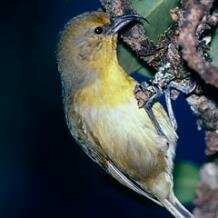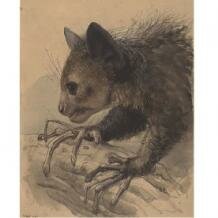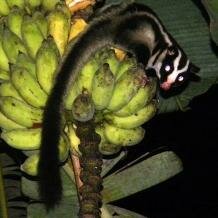Topic: Woodpeckers and woodpecker-like birds and mammals
You think woodpeckers are unique? Consider the ovenbirds. Or even the curious aye-aye.
Woodpeckers (Picidae) are a highly successful group of birds.  Despite being monophyletic, the group itself shows various convergences, for example with respect to behaviour (e.g. in the large “conglomerate” genus Picoides) or plumage (e.g. between Veniliornis and Piculus, where an olive colouration tinged with red and yellow might aid camouflage in dark, tropical forests). But woodpeckers are particularly famous for their ability to hammer into wood – for example to obtain food such as wood-boring grubs or tree sap – and the specific adaptations that allow them to do so. These include not only a specially designed skull to resist the effects of percussive hammering, a strong, sharp beak and an elongate, sticky tongue with bristles to extract insects, but also “sawdust protection” for the eyes and nostrils and stiff tail feathers that serve as a prop.
Despite being monophyletic, the group itself shows various convergences, for example with respect to behaviour (e.g. in the large “conglomerate” genus Picoides) or plumage (e.g. between Veniliornis and Piculus, where an olive colouration tinged with red and yellow might aid camouflage in dark, tropical forests). But woodpeckers are particularly famous for their ability to hammer into wood – for example to obtain food such as wood-boring grubs or tree sap – and the specific adaptations that allow them to do so. These include not only a specially designed skull to resist the effects of percussive hammering, a strong, sharp beak and an elongate, sticky tongue with bristles to extract insects, but also “sawdust protection” for the eyes and nostrils and stiff tail feathers that serve as a prop.
Jared Diamond has argued that the very uniqueness of the woodpecker can be used to reinforce the widely held neo-Darwinian view that evolution is effectively open-ended and indeterminate. Evolutionary convergence, however, suggests that very much the opposite conclusion can be reached, as several birds other than woodpeckers have evolved woodpecker-like habits, and there are even analogues amongst the mammals – and again we find convergences between placentals and marsupials!
Woodpecker-like birds
A number of birds from different families have adopted woodpecker-like forms and behaviours, particularly on islands that were not colonised by woodpeckers.
Vangas
The Vangidae of Madagascar show a bewildering array of ecologies and morphologies (with large variation in body size, beak shape and colouration) and evidently represent an extensive endemic radiation. Indeed so different are some of the genera from each other that only with the advent of molecular methods were the close relationships identified. The family’s striking diversification was facilitated by the availability of vacant niches on this island, from which several bird families, including woodpeckers, are absent. Some vangids fill a woodpecker-like role, especially the sickle-billed vanga (Falculea palliata) that probes into tree trunks in search of wood-boring insects.
Akiapolaau
 Also found on an oceanic island, the endangered akiapolaau (Hemignathus munroi) is a member of the Hawaiian honeycreepers (Drepanidinae) that are another classic example of adaptive radiation (and convergence). Larval invertebrates living under the bark of koa trees (Acacia koa) are the akiapolaau’s main food source, but as their availability fluctuates, the bird additionally drinks sugar-rich phloem sap from ohia trees (Metrosideros polymorpha). Individuals defend particular ohia trees called aki trees, which are selected on the basis of criteria such as sap flow and bark structure. To feed, the bird drills roughly horizontal rows of holes into the bark, using its short, sharp mandible. The long, curved upper beak is used as a probe, and the emerging sap is collected with the tongue. Hence, the akiapolaau has converged on sap-feeding woodpeckers such as the yellow-bellied sapsucker (Sphyrapicus varius) and the white-fronted woodpecker (Melanerpes cactorum).
Also found on an oceanic island, the endangered akiapolaau (Hemignathus munroi) is a member of the Hawaiian honeycreepers (Drepanidinae) that are another classic example of adaptive radiation (and convergence). Larval invertebrates living under the bark of koa trees (Acacia koa) are the akiapolaau’s main food source, but as their availability fluctuates, the bird additionally drinks sugar-rich phloem sap from ohia trees (Metrosideros polymorpha). Individuals defend particular ohia trees called aki trees, which are selected on the basis of criteria such as sap flow and bark structure. To feed, the bird drills roughly horizontal rows of holes into the bark, using its short, sharp mandible. The long, curved upper beak is used as a probe, and the emerging sap is collected with the tongue. Hence, the akiapolaau has converged on sap-feeding woodpeckers such as the yellow-bellied sapsucker (Sphyrapicus varius) and the white-fronted woodpecker (Melanerpes cactorum).
Ovenbirds and woodcreepers
The Furnariidae are a major group of Neotropical birds that too have undergone an immense adaptive radiation. There is an ongoing debate regarding the taxonomy of this large, morphologically heterogeneous family that is commonly referred to as the ovenbirds. Woodcreepers are sometimes considered a subfamily of the furnariids (Dendrocolaptinae) and sometimes placed in their own family (Dendrocolaptidae).  Unsurprisingly, a woodpecker-like ecomorph has emerged in this diverse group, notably in the wedge-billed woodcreeper (Glyphorynchus spirurus) and Xenops. Xenops had traditionally been considered an aberrant ovenbird, until a molecular phylogenetic analysis demonstrated it to be a basal woodcreeper (this result was, however, later disputed by another study). The cranial features of Glyphorynchus and Xenops are remarkably similar to those of woodpeckers. A “swollen” forehead, spongy tissue in the skull, modifications to certain bones for the attachment of large muscles and sturdy ossification of the nasal septa all serve to stabilise the base of the beak and absorb physical shocks. Xenops, which uses its curved, laterally flattened beak to split twigs and chisel holes in decaying wood, resembles a piculet, while the very small Glyphorynchus, which flakes bark, hammers wood and gleans with the tip of its dorsoventrally flattened beak, has converged on a diminutive woodpecker. Jon Fjeldså and colleagues refer to this as “a remarkable parallelism” with the woodpeckers (Fjeldså et al. 2005, Journal of Ornithology, vol. 146, p. 1).
Unsurprisingly, a woodpecker-like ecomorph has emerged in this diverse group, notably in the wedge-billed woodcreeper (Glyphorynchus spirurus) and Xenops. Xenops had traditionally been considered an aberrant ovenbird, until a molecular phylogenetic analysis demonstrated it to be a basal woodcreeper (this result was, however, later disputed by another study). The cranial features of Glyphorynchus and Xenops are remarkably similar to those of woodpeckers. A “swollen” forehead, spongy tissue in the skull, modifications to certain bones for the attachment of large muscles and sturdy ossification of the nasal septa all serve to stabilise the base of the beak and absorb physical shocks. Xenops, which uses its curved, laterally flattened beak to split twigs and chisel holes in decaying wood, resembles a piculet, while the very small Glyphorynchus, which flakes bark, hammers wood and gleans with the tip of its dorsoventrally flattened beak, has converged on a diminutive woodpecker. Jon Fjeldså and colleagues refer to this as “a remarkable parallelism” with the woodpeckers (Fjeldså et al. 2005, Journal of Ornithology, vol. 146, p. 1).
Woodpecker finch
Finally, the aptly named woodpecker finch (Camarhynchus pallidus), one of the famous Darwin’s finches (Geospizinae) endemic to the Galápagos islands, should not go unnoticed. This species fills the niche of a woodpecker without actually showing any morphological adaptations. It compensates for this deficit by employing a tool – a twig or a cactus spine that may be shortened if required – in order to extract insects from trees. Up to half of their prey is acquired with the help of tools during the dry season, rendering these finches even more routine tool users than chimpanzees.
Mammalian ‘woodpecker’ analogues
Remarkably, even a number of mammals have converged on a woodpecker-like habit, including extant as well as extinct placentals and marsupials. They all share several anatomical features that are functionally correlated with woodpecker-like behaviour, such as prominent incisor teeth and elongate digits that take over the role of the woodpecker’s beak and tongue, respectively.
Aye-aye

 Most often cited among the mammalian woodpecker analogues is the remarkable aye-aye (Daubentonia madagascariensis), a nocturnal, arboreal lemur from Madagascar that feeds on wood-boring grubs in the rainforest. It taps the wood with its extremely long and thin middle finger and listens for sounds made by potential prey. Interestingly, such tap-scanning, which has been speculated to require well-developed cognitive capacities, finds a convergence in South American brown capuchin monkeys (Cebus apella) that search for insects within bamboo. Once the aye-aye has found a larva, it tears off the bark with its huge incisor teeth (which are in fact so striking that they were long supposed to indicate an affinity to squirrels) and probes the crevice with its elongate finger (which is almost as flexible as a woodpecker’s tongue). A number of peculiar cranial traits are also related to this feeding mode.
Most often cited among the mammalian woodpecker analogues is the remarkable aye-aye (Daubentonia madagascariensis), a nocturnal, arboreal lemur from Madagascar that feeds on wood-boring grubs in the rainforest. It taps the wood with its extremely long and thin middle finger and listens for sounds made by potential prey. Interestingly, such tap-scanning, which has been speculated to require well-developed cognitive capacities, finds a convergence in South American brown capuchin monkeys (Cebus apella) that search for insects within bamboo. Once the aye-aye has found a larva, it tears off the bark with its huge incisor teeth (which are in fact so striking that they were long supposed to indicate an affinity to squirrels) and probes the crevice with its elongate finger (which is almost as flexible as a woodpecker’s tongue). A number of peculiar cranial traits are also related to this feeding mode.
Trioks and striped possum
 In Australia and New Guinea, where woodpeckers are absent as well, the largely arboreal marsupials in the small genus Dactylopsila (family Petauridae) have taken over. Whilst not much is known about the biology of the three triok species that are restricted to remote rainforests of New Guinea, the striped possum (D. trivirgata), which has extended its range into Australia, is somewhat better known. Anatomical specialisations for feeding on wood-boring larvae in Dactylopsila include powerful jaws with large incisors to tear off bark (the striped possum has the relatively largest lower incisors of all possums), cranial modifications that strengthen the skull against physical stress and an elongate fourth finger (note how convergence is never perfect…). Intriguingly, the striped possum has been observed to tap rapidly on wood with its forepaws to locate the larvae. The relevant cranial adaptations, however, seem to be most pronounced in the long-fingered triok (D. palpator).
In Australia and New Guinea, where woodpeckers are absent as well, the largely arboreal marsupials in the small genus Dactylopsila (family Petauridae) have taken over. Whilst not much is known about the biology of the three triok species that are restricted to remote rainforests of New Guinea, the striped possum (D. trivirgata), which has extended its range into Australia, is somewhat better known. Anatomical specialisations for feeding on wood-boring larvae in Dactylopsila include powerful jaws with large incisors to tear off bark (the striped possum has the relatively largest lower incisors of all possums), cranial modifications that strengthen the skull against physical stress and an elongate fourth finger (note how convergence is never perfect…). Intriguingly, the striped possum has been observed to tap rapidly on wood with its forepaws to locate the larvae. The relevant cranial adaptations, however, seem to be most pronounced in the long-fingered triok (D. palpator).
Extinct mammals
A fossil family of placental mammals, the Apatemyidae, lived in North America, Europe and possibly India during the Eocene. It is likely that all members of this presumably arboreal taxon resembled woodpeckers, but they showed different degrees of specialisation – from relatively modest in the oldest genus Jepsenella to high in the youngest genus Sinclairella. Craniodental and postcranial adaptations were very similar to the extant mammalian woodpecker analogues, again including a characteristic dentition with enlarged procumbent incisors, and the second and third finger being elongated.
Recently, another extinct potential “mammalian woodpecker” has been reported, the marsupial Yalkparidon from the Oligo-Miocene of Australia. Again, highly derived dental specialisations in addition to features that strengthen the skull against rostral bending indicate a woodpecker-like feeding mode. However, the skeletons recovered so far are incomplete, so it is not yet known whether Yalkparidon also possessed elongate digits. As Robin Beck noted, “if Yalkaparidon was indeed a ‘mammalian woodpecker’ (…), the fact that a fourth mammalian group appears to have independently evolved to occupy this niche demonstrates par excellence the pervasive and iterative nature of convergent evolution” (Beck 2009, Biological Journal of the Linnean Society, vol. 97, p. 14).
Sap-feeding mammals
 Unsurprisingly, not only the akiapolaau, but also some mammals have converged on sap-feeding woodpeckers. These include two Australian marsupials of the genus Petaurus in the family Petauridae, the yellow-bellied glider (P. australis) and the sugar glider (P. breviceps).
Unsurprisingly, not only the akiapolaau, but also some mammals have converged on sap-feeding woodpeckers. These include two Australian marsupials of the genus Petaurus in the family Petauridae, the yellow-bellied glider (P. australis) and the sugar glider (P. breviceps).  Yellow-bellied gliders depend on eucalyptus sap, although the importance of this food source can vary hugely. To obtain sap, they make incisions in the bark using their lower incisor teeth. Similar to the akiapolaau, the gliders only drink from particular trees and apparently sample a number of trees to find those with high sap flow. The smaller sugar glider takes plant exudates as well, but also invertebrates (aided by its elongated fourth finger) due to its higher energy requirements. Other mammals that have been observed to make incisions in trees to feed on sap include some marmosets and Abert’s squirrels (Sciurus aberti).
Yellow-bellied gliders depend on eucalyptus sap, although the importance of this food source can vary hugely. To obtain sap, they make incisions in the bark using their lower incisor teeth. Similar to the akiapolaau, the gliders only drink from particular trees and apparently sample a number of trees to find those with high sap flow. The smaller sugar glider takes plant exudates as well, but also invertebrates (aided by its elongated fourth finger) due to its higher energy requirements. Other mammals that have been observed to make incisions in trees to feed on sap include some marmosets and Abert’s squirrels (Sciurus aberti).
Cite this web page
Map of Life - "Woodpeckers and woodpecker-like birds and mammals"
https://mapoflife.org/topics/topic_132_woodpeckers-and-woodpecker-like-birds-and-mammals/
July 31, 2017

